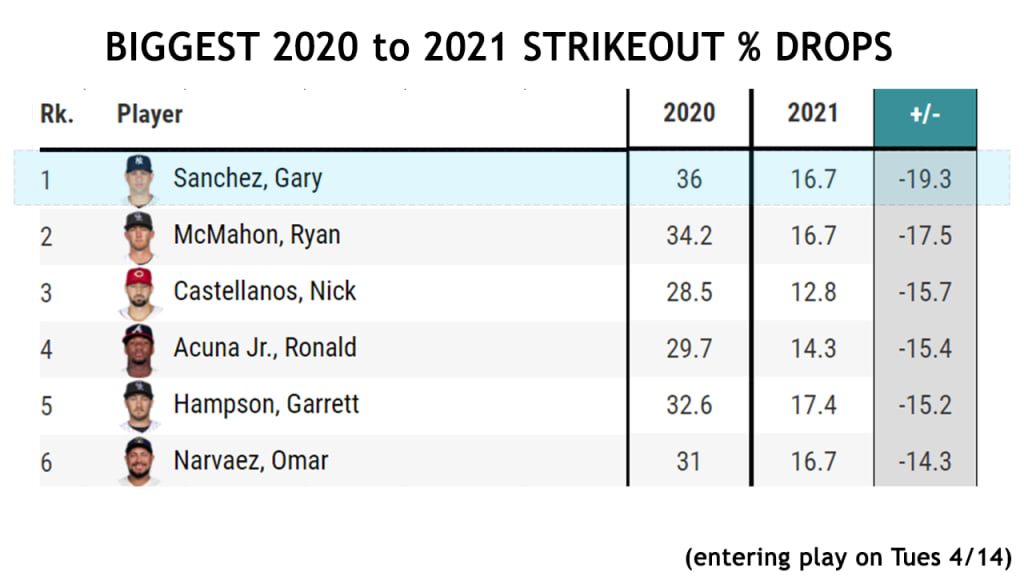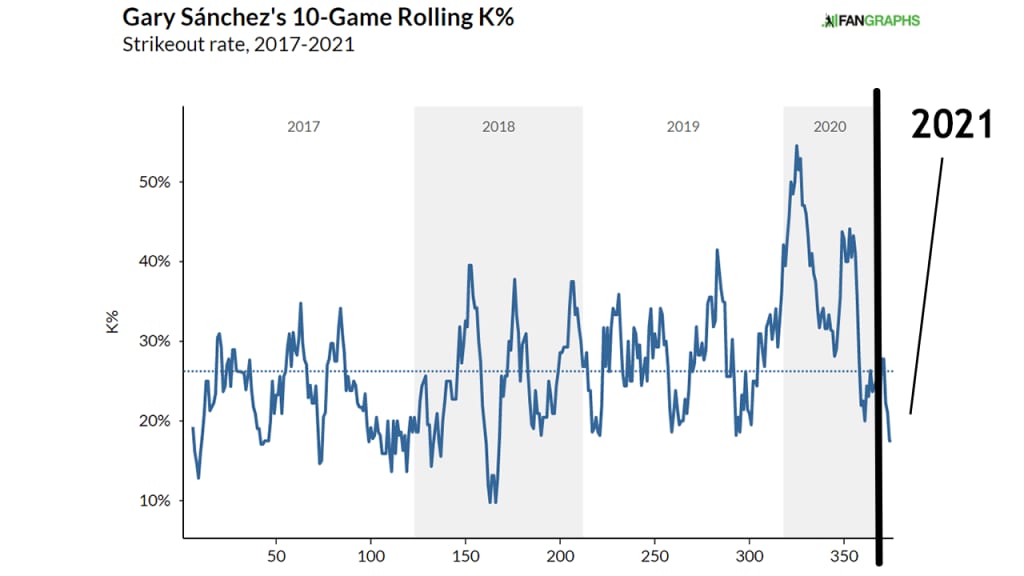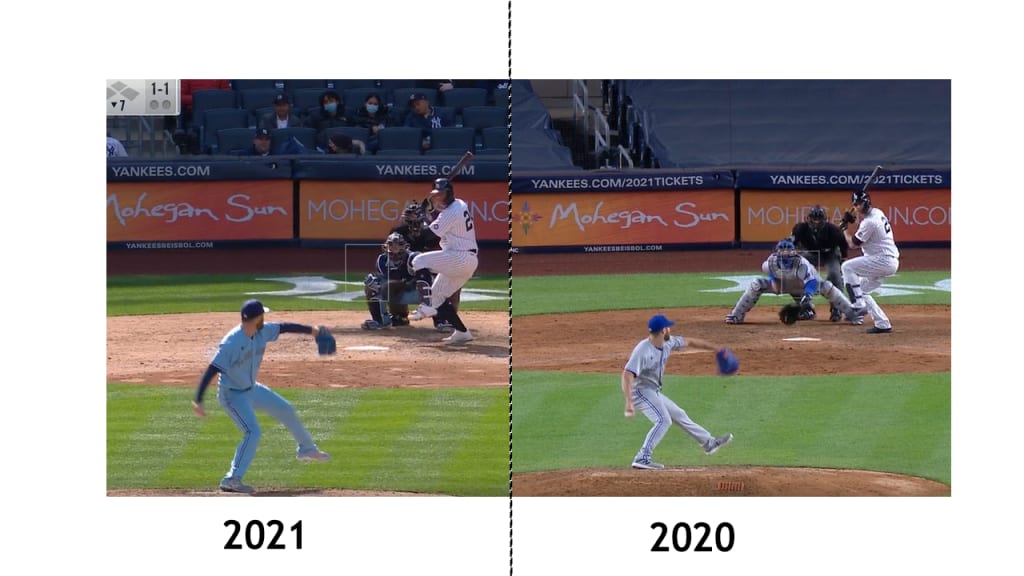In the midst of what’s been a deeply frustrating start to the season for the Yankees, there is a sliver of good news, and it’s from a most welcome place: Gary Sánchez is doing a considerably better job of making contact this year. Actually, he’s doing the best job of making more contact this year. No one, early on, has cut their strikeout rate by as much as he has. In 40 times up, he's been fanned seven times.

There’s an obvious caveat to that, of course, which is that it’s hard to cut your strikeout rate by that much unless you were having a pretty bad whiff problem in the first place, and Sánchez’s 36% whiff rate last year was indeed a problem. It’s not possible for, say, D.J. LeMahieu to show up with a strikeout rate 20 points lower than last year, because he only had a 9.7% K rate in 2020 anyway.
Still, considering how dreadfully bad of a season Sánchez had in 2020 -- a .147/.254/.365 line that ended with mostly-unfounded cries from fans to have him not tendered a contract after the end of the year -- you’ll take whatever sense of improvement you can get.
We want to get to why, and we will, but there’s a far more important question first. It’s 10 games. It’s 40 plate appearances. It’s something like five percent of how many times to the plate you’d hope he would get this year. If this is merely “a weird thing that could happen over any random 40 plate appearance” time span, then it’s meaningless and we can stop right here. So: Is it?
This is a notable run of contact for Sánchez
To answer that question, we looked at every 40 plate appearance chunk of Sánchez’s career, starting with a simple premise: In every 40-PA run, of which there are over 1,500 in his career, how often has he whiffed more than seven times? The answer to that is: Most of them. More than 85% of them, actually.
So right away, we can say something interesting: Sánchez getting through 40 plate appearances with seven or fewer whiffs is a Top 15% outcome for him. (Look, the man strikes out a lot. In one 40-PA stretch last summer, he struck out 20 times, which is … too many times.)
Knowing that, let’s find out when those “struck out 7 or fewer times in a 40-PA span” stretches have happened. That’s not just good for Sánchez, by the way, it’s just good overall. That’s a 17.5% strikeout rate, and right now the Major League average is north of 24%.
Here’s all the 40-PA stretches he’s had 7 or fewer whiffs.
2016 -- 39 times
2017 -- 121 times
2018 -- 64 times
2019 -- 9 times
2020 -- 0 times
OK, so a few things. First, zero times in 2020. Not once! Second, note the trend. Some of this is about playing time, because he’s dealt with injuries over the year, but also he was able to do this somewhat regularly in 2017, and barely at all over the last two years -- including, again, zero times last year.
So, for Sánchez to even manage to do it at all again is noteworthy. Plus, if you were to look at his rolling 10-game strikeout chart, you can see that he’s done this before. If anything is the outlier, it was 2020 -- and wasn’t 2020 a nightmarish outlier for us all?

That all being said, it seems interesting enough that maybe it’s not just a fluke. He doesn’t do this 85% of the time, and he hasn’t done it in nearly two years, and now, he’s doing it. (More interestingly, perhaps, is that three of the strikeouts came in one game, on Apr. 5 against Baltimore. His nine other starts have all had one or zero strikeouts.)
The next question, then, is why.
What's causing his strikeout drop?
There’s really three good ways to strike out less. Let’s see if he’s doing them.
1. Is he making more contact?
No. You’d think it’s “yes,” but it’s not “yes,” it’s “no.” Entering Tuesday’s game, Sánchez had made contact on 70% of swings. His career rate is 72%. Last year, it was 69%. This mostly isn’t it.
2. Is he being more aggressive?
Sort of. You can’t strike out if you aren’t in two-strike counts, after all. That would be a good way to not strike out. And wouldn’t you know it: He’s actually finding himself in two-strike counts less than he ever has before, at just 23% entering Tuesday, and down from 32% last year. This explains a lot of the whiff decrease.
But … he’s actually swinging at the first pitch a career low in 2021. And he’s not swinging more overall. Instead, the real answer here seems to be with our third idea:
3. Is he making better swing decisions?
Yes. A lot. It’s early, obviously, but still. Part of the reason his first-pitch swing rate is down is because he’s seeing fewer strikes on the first pitch, a career low. His rate of swings at pitches outside the zone is a career best 20.5%, well down from last year’s 28.8%. His rate of swings inside the zone is a career best 68.1%, well up from last year’s 61.1%. Better swing decisions lead to better swing outcomes.
Now: is that a fluke? We’re certainly not saying this is proof that any of this lasts all season. But we do know that he went to work immediately after the end of last year’s disappointing campaign.
“Sánchez said that the coaches stressed keeping his weight back, placing more pressure on his right leg to let the pitch travel further, then striking the ball with a compact swing,” wrote MLB.com’s Bryan Hoch. “The batting-practice homers littering a grassy area beyond the left-field wall of a practice field suggest that Sánchez is applying those suggestions well.”
In February, former Major Leaguer Trevor Plouffe, who hit 106 home runs over a nine-year career, broke down Sánchez’ swing in a video segment, and came away with the opinion that his timing was off against fastballs. That makes sense; Sánchez in 2020 struggled badly against velocity, to the point that teams early in 2021 are throwing him heaters more than they ever have before, up to 65%.
The problem is, we wanted to show you here big evidence that Sánchez was changing that leg kick to improve his pitch recognition and recognize fastballs better. But after reviewing a bunch of video, it's hard to say that's true. Can you see much difference in the stills below, each at home against righty Blue Jays pitchers?

If that's still a weakness, teams will figure it out quickly, because there's no shortage of hard-throwing arms out there. But even so, Sánchez has still managed to strike out far less than he did last year, and far less than he's done in 85% of the rest of his career. Good swing decisions go a long way there. It helps to not get yourself out. It might help you get pitches you'd rather be swinging at than the ones you know you can't catch up to. Either way, after last year? It's a reassuring start. It's one he badly needed.

